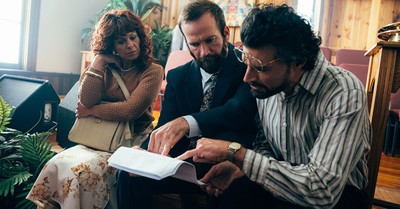Passing Through the Waters
- Heidi Hess Saxton Author or compiler of six books including Touched by Kindness
- Updated Oct 11, 2001

This is the second in a five-part series about milestones in the Christian faith, called “sacraments” in some Christian traditions, and how these experiences shape the faith of the believer. These five milestones include communion, baptism, confirmation, reconciliation (or confession), and anointing of the sick.
Two years after I became Catholic and moved to Michigan, I returned to California to experience the Easter Vigil a second time in my “home” parish, Holy Family Catholic Church in South Pasadena. As I walked up to the church entrance, I spotted the group to be baptized that night. A dozen adults wore the white sashes signifying their intent, including a couple of teenagers who huddled, giggling with excitement, near the fire that would light the Easter candle.
The set-up crew was adjusting the lights and equipment to capture the service for the sick and homebound on local cable television. Although this practice stretched their electrical system to the limit, it was something they did every year. My friend Dawn, who with her husband Frank runs the RCIA (Rite of Christian Initiation of Adults) program, settled next to me just before the procession started. “Those girls,” she whispered to me, “I don’t know what I’m going to do with them. They actually brought a blow dryer for after the baptism! I told them there would be no time …”
I smiled at the girls’ youthful vanity, and looked toward the back of the church, where the cantor carrying the lighted Easter candle had appeared at the entrance of the darkened sanctuary.
“Christ our light!” sang out the cantor.
“Thanks be to God!” the congregation responded.
Soon the entire church was ablaze with candlelight. A short time later we extinguished our candles as the sanctuary lights were turned on, bathing the room with dazzling brilliance; strains of the “Gloria” erupted in jubilant song.
When it was time for the baptisms, one by one the candidates stepped into the ankle-deep pool and bowed as Monsignor Connolly drenched them completely with water. With radiant smiles each person then stepped out of the pool and, barefoot, walked to the side door to change into dry clothes.
The last person to be baptized was just stepping into the water when a loud whirring sound emitted from the next room. Seconds later, the whole room went black. A strangled cry escaped from Dawn. “I told them to leave that dryer at home!”
Six months ago I attended another baptism. Touching the cheek of my new goddaughter Ruth as she sat in her mother’s lap, I marveled at the extraordinary blueness of her eyes. I was excited to see my goddaughter formally welcomed into her church family, although it was hard to imagine that such a sweet-smelling, adorable cherub would need to be cleansed from anything as distasteful as original sin. On the other hand, I knew that I was not exactly the most unbiased judge.
Just then, the priest motioned us forward.
“Here we go, Peaches.” Gently I removed the white christening bonnet from her bald head. She gurgled and cooed as her mother carried her to the font, then placed little Ruth in my arms. Holding the baby, I promised God that I would help Ruth’s parents to raise her to know and love Him. The water and oil, white garment and candle were tangible reminders of what had just taken place: another child had been born into the family of God.
I was baptized twice. I do not remember the first time; I was only a month old when my parents had me baptized at a Presbyterian church near the Air Force base on which my parents were living. When I was thirteen, I was dunked in the baptism pool at a local Baptist church. I remember the kindly expression of my pastor just before he pushed me under the water, then pulled me, sputtering, upright. Most of all, I remember the rush of excitement I felt as I squished up the steps of the concrete baptistery and saw the beaming faces of my parents. Later, when I was in Bible school, we used to sit around and debate (as theologians for centuries before and since) which was the “right” way to receive baptism. To tell you the truth, I’m still not sure. But this much I do know: The rite is a crucial first step on a lifelong journey of spiritual discovery.
“I tell you the truth, no one can enter the kingdom of God unless he is born of water and the Spirit,” Jesus reminded Nicodemus (John 3:5). Churches have differing opinions about the methodology: some sprinkle infants, others completely immerse only those old enough to make a profession of faith for themselves. Here is how some denominations view this rite of Christian passage.
Assemblies of God: Hold that baptism is “an ordinance of the Church,” and that “baptism by immersion is commanded in the Scriptures. All who repent and believe on Christ as Savior and Lord are to be baptized. Thus they declare to the world that they have died with Christ and that they also have been raised with Him to walk in newness of life. (Matthew 28:19; Mark 16:16; Acts 10: 47, 48; Romans 6:4). (From the General Council of Assemblies of God, Statement of Fundamental Truths revised 1983).
Lutheran: Lutherans believe that, in baptism, a person is born into the Kingdom of God and becomes an heir of salvation. It is the beginning of life of faith in which each day our human nature 'should be drowned through daily repentance’; and that day after day a new self should arise to live with God in righteousness and purity forever." (The Small Catechism, by Martin Luther)
Mennonite: Mennonites believe that “the baptism of believers with water is a sign of their cleansing from sin. Baptism is also a pledge before the church of their covenant with God to walk in the way of Jesus Christ through the power of the Holy Spirit. Believers are baptized into Christ and his body by the Spirit, water, and blood”.(,www.mennolink.org, Article 11).
Roman Catholic: Holy Baptism is the basis of the whole Christian life, the gateway to life in the Spirit and the door which gives access to the other sacraments. Through Baptism we are freed from sin and reborn as sons of God; we become members of Christ, are incorporated into the Church and made sharers in her mission: "Baptism is the sacrament of regeneration through water in the word.” (Catechism of the Catholic Church, par 1213)
Presbyterian: Baptism, whether administered to those who profess their faith or to those presented for Baptism as children, is one and the same Sacrament. The Baptism of children witnesses to the truth that God's love claims people before they are able to respond in faith. (Book of Order W-2.3008)
Southern Baptist: Christian baptism is the immersion of a believer in water in the name of the Father, the Son, and the Holy Spirit. It is an act of obedience symbolizing the believer's faith in a crucified, buried, and risen Savior, the believer's death to sin, the burial of the old life, and the resurrection to walk in newness of life in Christ Jesus. It is a testimony to his faith in the final resurrection of the dead. Being a church ordinance, it is prerequisite to the privileges of church membership and to the Lord's Supper.(Report of the Baptist Faith and Message Study Committee to the Southern Baptist Convention Adopted, June 14th, 2000)
As we study references to water in the New Testament, it is immediately clear why the Lord chose water as the sign of His covenant love for us. He used water to give sight to the blind (John 9:7ff), and as a symbol of faithful service (John 13:5ff) in the New Testament; it was an elixir to mend broken bodies (2 Kings 5:9-14) and to cleanse the earth of evil (Genesis 6:17ff) in the Old. In the waters of baptism the soul is purified and regenerated. Through these waters, the Spirit makes us members of the body of Christ. “For by one Spirit we were all baptized into one body -- Jews or Greeks, slaves or free -- and all were made to drink of one Spirit” (1 Corinthians 12:13).
Baptism is not unlike physical birth, when a new life is brought into the world to grow to maturity. Through baptism we are introduced to and welcomed into our church family, cleansed of soulish impurities, and begin to grow in grace. Guided by the Spirit and more mature Christians, we begin to learn how to love God and serve Him with loving obedience and resolve.
Like the Israelites who passed through the Jordan River to the Promised Land, in baptism we pass through waters in order to set our steps more firmly and surely along the heavenly road. We do not have to be afraid of what is in store for us, or worry that we won’t be able to keep up with those stronger or smarter than ourselves. God’s Spirit goes before us, guiding us from the time we are “wet behind the ears” until we see our Father face to face.
Copyright 2001 Heidi Hess Saxton. All Rights Reserved.
Heidi Hess Saxton is the author or compiler of six books including Touched by Kindness (Servant Publications). You can find out more about Heidi, or contact her, through her Website: www.christianword.com.



















